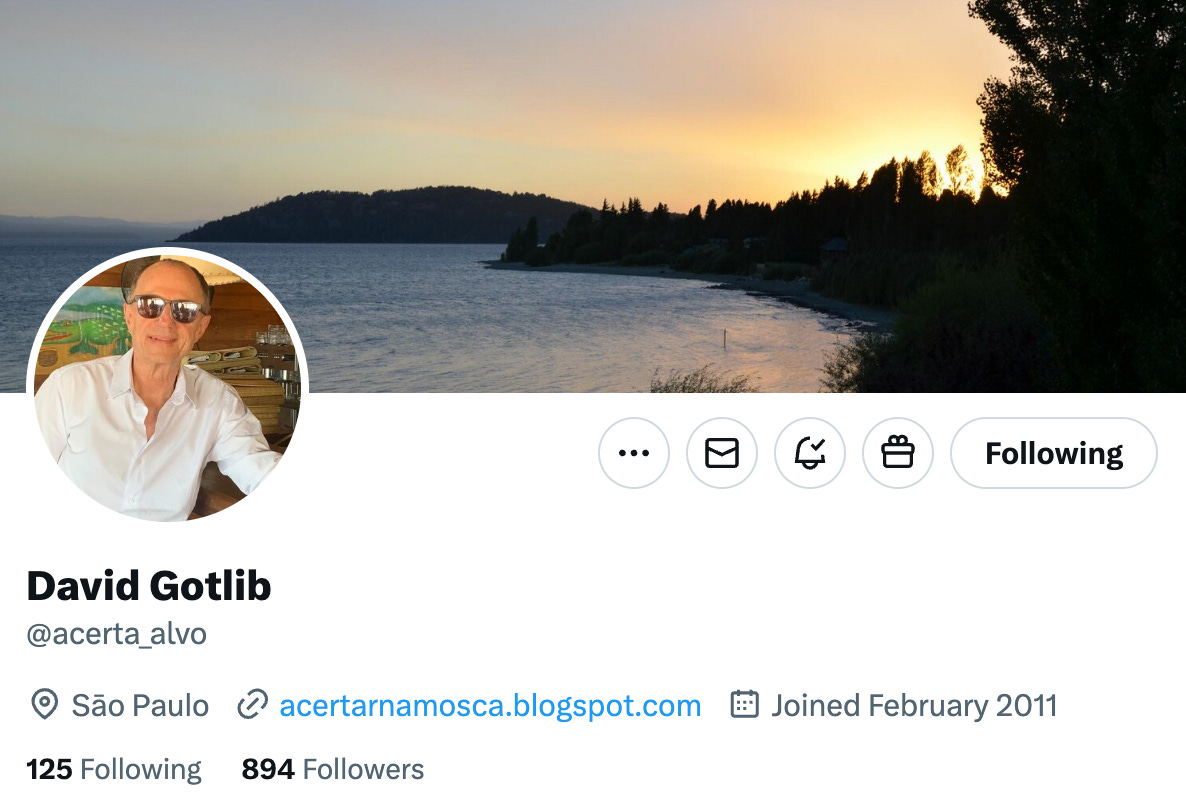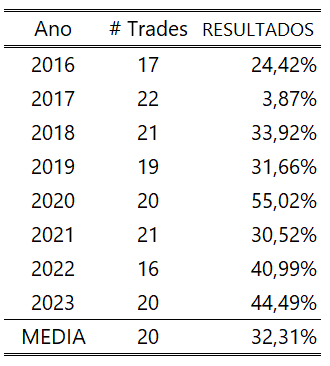Brazil Value Talks: David Gotlib (Acertar na Mosca)
Multiplied Invested Capital by 12x versus 3x for the S&P 500 in 8 Years
I had the honor of talking to an investor with decades of experience in the market and who was one of the founders of the first hedge fund in Brazil:
David currently manages his own portfolio and is the author of the blog Acertar na Mosca, where he has been sharing his thoughts on the global economy and financial markets on a daily basis since 2011. Mosca has already accumulated more than 3,000 publications and has been consulted by more than 850,000 readers in Brazil, the United States and Europe.
From January 2016 to September 2024, his historic performance will be the envy of anyone.
His portfolio returned more than 1067.37% (USD) in the period, versus 179.53% for S&P 500.
He multiplied the invested capital by 12x!
In 2024, the accumulated performance is +24.29% in USD.
This guy knows how to generate real value.
Shall we meet him?
BS: David, could you tell us a little about yourself?
DG: I have a long career in the financial market, over 45 years. When I started, there were no microcomputers, Bloomberg, and much less cell phones or WhatsApp.
At that time, those who knew how to do math had a huge advantage, which is why banks looked for engineers.
BS: Could you tell us a little more about your academic background and how you ended up in the financial market?
DG: I graduated in Production Engineering from University of São Paulo - Brazil and, naturally, I went to work in a factory right after graduating. One day, a friend from college who worked at Banco Francês e Brasileiro told me that they were looking for engineers and asked if I would like to do an interview.
At one point in the conversation, my future boss asked: "What do you know about banks?" I was honest and said: "I don't know anything, but I'm really curious about how people make money."
I was hired and I've never left the market since; I see the market as "financial cocaine" — it's addictive and you can't stop! Hahaha...
BS: What was it like to participate in the creation of the first Brazilian hedge fund in the 1990s?
DG: Linear was a startup at the time. The idea came from a trip I took to the US. Fidelity Investments inspired me to create something similar here. I already had a relationship with my former partners: Ibrahim Eris, Luis Paulo Rosenberg and Emir Capez, and I proposed that we join forces to create the first Hedge Fund in Brazil in 1993. The asset ended up having USD 1 billion under management.
After Linear, between 1999 and 2002, I was Managing Director of Deutsche Bank Asset Management, coordinating the management of funds totaling R$2.2 billion until the company was sold to Bradesco.
BS: Considering the enormous volume of currency issuance since 2008, depreciating the dollar, where should we invest to maintain purchasing power?
DG: The high volume of currency since 2008 has created numerous distortions in the markets, especially in interest rates. At this point, the dollar is always the candidate for this question. I do not have a negative view of the American currency for several reasons, the main ones being: it is still by far the main currency of exchange; and the volume of existing bonds compared to other currencies (euro, yen, etc.) still makes it a logical preference in portfolios.
I would be concerned about the dollar if there were, for example, an increase in inflation caused by a blunder (or political action) that led to an accelerated devaluation of the currency. In this case, gold would be the natural safe haven, and perhaps Bitcoin.
Regarding the latter, I am skeptical about classifying it as anything: currency, safe haven, etc. For me, they are just bits, like a perpetual bond without a coupon, which needs more and more followers every day to increase in value. For now, it serves as a "currency" for shady operations or escape in countries where the currency is in free fall.
BS: What is your strategy for making money in the financial market?
DG: Buy cheap and sell expensive! Hahaha... Actually, since I started using technical analysis, this phrase has sometimes been reversed — a more provocative statement. If I had to summarize, I would say that the key to success is the discipline of a methodology combined with financial risk control — knowing the amount you are willing to lose is essential. The secret is to "keep playing the game with chips."
BS: What made you interested in technical analysis?
DG: In the early 2000s, I was heavily involved in the G10 foreign exchange market. The main reason, as mentioned above, was the "lucky break" I had with a euro position. Thanks to this position, which I bought on the fly (and the fly didn't even exist at that time) at €0.84 and sold at approximately €1.25, I ended up entering the world of technical analysis. How did it happen? Initially, I followed my namesake, David Rosenberg, who was the chief economist at Deutsche Bank and suggested, for fundamentalist reasons, buying. He was also the one who suggested selling at €1.25.
I made a large allocation, 100% of my assets — crazy, when you think about it. You can imagine what the daily fluctuations were like. After riding that rally, I thought I understood everything and, above €1.25, I decided to sell. My venture didn't last long, because after taking a loss, I closed the position at €1.30. I believe that what saved me was that I started following Andrew Baptiste, who was responsible for technical analysis at Morgan Stanley and had a more bullish view of the single currency. I saw the market reach €1.60 and decided to study the subject. I never stopped.
Note: excerpt from the post Os modelos (in)eficientes from the blog Acertar na Mosca.
BS: What percentage of your portfolio usually goes to fixed income, and what type of securities do you buy?
DG: Here in Brazil, it's around 90%. Is that exaggerated? Without a doubt, but it's compatible with the high interest rates. We have to "thank" the government, which likes to spend more than it should, forcing the Central Bank to charge high interest rates. Why invest in stocks?
Abroad, it depends on each person's level of risk, according to the models that exist. I don't believe that individual allocation is of much value due to its particularity.
BS: Why do you invest heavily in indexes, where competition is much greater than in specific stocks?
DG: I will give my opinion on the international market, especially the American one. I do not believe in stock portfolios; all you need to do is look at the performance of active funds, whose managers are, in principle, much better than ours. I recently gave a presentation at FEA and presented a chart that needs no comment:
After 1 year, 60% of active funds fail to outperform their benchmark;
After 5 years, this percentage rises to 80%; and
After 10 years, it reaches 90%.
If you find a fund that outperforms, it is by pure luck.
BS: But perhaps by investing in less liquid stocks, where the funds are not, it is possible to obtain alpha, right? Why don't you use foundation? Don't believe it works?
DG: I think it is very difficult for any investor to discover a stock that will have positive performance, especially if it is not liquid. I don't like. I'm of the opinion that, if it works out, it's much more by luck. Let's take the most well-known stock indicator, the P/L. It is established that a P/E of 10 (for example) is cheap and 15 is expensive, and worse: the entire market believes it. Who am I to question?
I ask the following question: Will this company be alive in 10 years? What is the probability that "L" will remain "stable" until then? Therefore, if there is a hit, I believe it is more by luck.
BS: What is your process for identifying a new investment opportunity?
DG: From this interview, for those who don't know me, you can already see my pragmatism. My opportunities are based on charts, naturally for opportunistic positions and risk participation adjustments in portfolios.
BS: Which strategy usually works best: mean reversion or trend following?
DG: There is no hard and fast rule. I use the Elliot Wave technique, and these concepts do not apply to this methodology.
BS: What precautions should investors take when using Elliot Wave?
DG: I have been using Elliot Wave for over 20 years, and I can say that it is an iterative process of constant learning. There are only three rules to follow: Wave 3 cannot be the smallest; there can be no overlap between wave 4 and wave 2; and wave 2 cannot go back further than the beginning of wave 1. That's it. The rest are parameters, but nothing mandatory.
The care to be taken is not to become a fan. If your strategy went wrong, reset it and move on to another.
BS: Which assets do you think most closely follow Elliot Wave patterns?
DG: I would say that they are applicable to virtually any asset. However, there are some whose use is more questionable. For example: interest rate markets (bonds), especially the shorter ones, due to the strong influence of central banks; and assets with little history, which compromise the longer-term vision (no IPO!).
BS: How do you define the best point to place a stop that protects your investment and, at the same time, is not triggered by market volatility?
DG: Initially, it depends on your budget. In fact, the process is the opposite: given how much you are willing to lose, you define the size of the position considering the stop loss.
In my opinion, the stop loss is valid for the speculative portfolio. When it comes to portfolios, I look at it differently. In simple terms, I establish a range, mainly for the stock portfolio, that will fluctuate according to the market's view.
BS: How much, in percentage, are you willing to lose on each trade? Or what is the ratio of potential gain vs. maximum loss that you accept?
DG: I think it should always be a proportion of the capital allocated to these trades. A good metric would be around 2%.
BS: What asset traded on the American stock exchange has the greatest potential for growth (or the best risk/return) in your portfolio today? Could you briefly explain the case?






